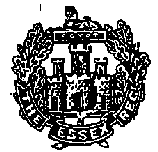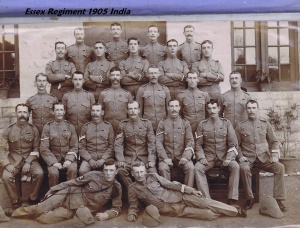44th Regiment of Foot
The Essex Regiment known as The Pompadours
Contents
Chronology
- 1741 raised as James Long's Regiment of Foot (ranked as the 55th Regiment of the Line)
- 1748 re-ranked as the 44th Regiment of the Line
- 1751 renamed the 44th Regiment of Foot
- 1782 became the 44th (East Essex) Regiment of Foot
- 1881 amalgamated with the 56th (West Essex) Regiment of Foot to become 1st Battalion Essex Regiment
- 1958 merged with the Bedfordshire and Hertfordshire Regiment to form the 3rd East Anglian Regiment (16th/44th Foot)
- 1964 became 3rd Battalion of the new Royal Anglian Regiment
- 1992 3rd Battalion disbanded
Campaign Actions
Battle of Bemaru 1841
Battle of Gundamak 1842
Battle of Sinho 1860
Battle of Taku Forts 1860
History
| The information in this section has been extracted from a number of sources, including Thomas Carter's 'Historical Record of the Forty-Fourth or the East Essex Regiment of Foot' (1864), John W. Burrows' 'The Essex Regiment : Short History and Chronology' (undated, but after World War One), 'The British Army of 1914' and various War Office documents such as Muster Rolls and pension records. |
The regiment has a distinguished history, having fought at Waterloo in 1815 and throughout the Crimean War 1854-1856, as well as numerous other famous and not-so-famous battles. However, as this website is primarily concerned with family history in India, only the India-related history will be recounted.
The regiment formed the rearguard of the British Indian Army on the retreat from Kabul during the 1st Afghan War. There were only eight survivors from the last stand at Gundamak. The regiment had to be reconstituted for the Crimean War.
- Memorial in Alverstoke Church, near Gosport - "Sacred to the memory of Colonel T. Mackrell, ADC to Her Majesty. Major W.B. Scott, Captain T. Swaine, Captain R.B. McRea, Captain T.R. Leighton, Captain T. Robinson, Captain F.C. Collins, Lieutenant W.H. Dodgin, Lieutenant W.G. White, Lieutenant W.G. Wade, Lieutenant H. Cadett, Lieutenant S. Swinton, Lieutenant F.J.C. Fortye, Lieutenant A.W. Gray, Paymaster T. Bourke, Lieut. and Qr. Master R.B. Halahan, Surgeon J. Harcourt, Assistant Surgeon W. Balfour, Assistant Surgeon W. Primrose. And 645 non-commissioned officers and soldiers of the 44th Regiment, who fell upon the field of battle in the disastrous Affghan War of 1841 and 1842. They sank with arms in their hands unconquered, but overpowered by the united horrors of climate, treachery, and barbarous warfare; their colours saved by Captain J. Souter, one of the few survivors, hang above this stone, which is erected to their memory by the officers of the 44th Regiment, June 1844." (http://glosters.tripod.com/FAfghan.htm)
In consequence of the Indian Mutiny, reinforcements had to be sent to all the Presidencies at short notice. The 44th had not long returned to England from the Crimea when it was selected as one of the regiments to reinforce India. On 26th August 1857 the regiment embarked for Madras, arriving on 12th January 1858. The women and children were left at home. During the years 1858 and 1859, the regiment remained at Fort St George, Madras, from whence it proceeded on active service.
War with China (2nd China War) had broken out, owing to the Emperor refusing to ratify the treaty which had been signed two years previously by his ministers at Tien-Tsin. In this campaign, as in the Crimea, the French and British forces acted together. The 44th embarked for China on 31st January 1860. The women and children of the regiment arrived at Madras, from England, after the first detachment had departed, and were again left behind.
After landing at Kowloon, on the mainland opposite Hong Kong, the 44th proceeded on 15th May to the north of China, leaving the 'weakly men' behind at Hong Kong. On 16th June the regiment arrived at Talienwhan Bay, near the entrance of the Gulf of Pecheli, where the troops were employed in digging wells. The expedition re-embarked on 24th July and sailed for the Peiho River, and moved to the Pehtang River on 30th July.
The 44th took part in the capture of the Sinho entrenchments and the Battle of Taku Forts 1860, in which two Victoria Crosses were won. The attacking party of the 44th and 67th Regiments swam the ditch and tried to force an entrance by the gate, but without success. Some of them then climbed up the wall to an embrasure and also at a point to the right of the gate. Lieutenant Lenon of the 67th stuck his sword into the wall to enable Lieutenant Rogers of the 44th , who had been wounded, to enter the fort, the first British officer to do so. For this service, 'Taku Forts' was inscribed on the Colours.
The regiment returned to Fort St George, Madras. It was in Kamptee in Central India at least from 1876 to 1878, and then moved to Thyetmo in Burma in the first half of 1878. The Regiment was still at Thyetmo in 1881, when it was designated the First Battalion, The Essex Regiment, under which title it served in the South African War (1899-1902).
1906-1913
- 26/12/1906 Arrived Thayetmyo, Burma. 2 Companies detached to Meiktila and 2 Companies detached to Mandalay.
- 30/11/1908 Detachments embarked.
- 14/12/1908 Rest of Battalion embarked at Rangoon on the "Hardinge" for Calcutta en route for Sitapur
- 17/12/1908 Arrived Sitapur
- 11/03/1909 HQ and half Battalion at Ranikhet
- 31/10/1909 HQ and half Battalion at Quetta
- 06/11/1909 Remaining half Battalion left Sitapur
- 09/11/1909 Arrived Quetta
- 05/11/1913 Embarked Karachi, half Battalion to Mauritius on the "Soudan", other half to Durban[1]
World War 1
The 2nd Garrison Battalion, Essex Regiment was formed in Halton Park in January 1916 and moved to India, where it then remained until the end of 1918. It was based at Nasirabad as part of the Nasirabad Brigade, 5th (Indian) Division.[2]
Charles Dixon, was in B Company based at Inkerman Barracks, Nasirabad. There is a photograph taken at Landi Kotal Fort, NWF. He was also based at Mount Abu Sanitorium in May 1918[3] This was during the hot season when many troops were sent to hill stations.
A company is reported to have gone to Basra in Mesopotamia for work on Lines of Communication.[4]
FIBIS resources
Regimental flash
The flash, also known as a pagri (puggaree) badge, or Foreign Service Helmet badge, was generally affixed to the pagri on the sun helmet. Based on the regimental nickname the Purple Pompadours, the flash was a tall strip of purple material.[5]
Regimental histories
- The Essex Regiment. 1st Battalion (44th) 1741-1919 by John Wm. Burrows [1923]. Series: [Essex Units in the War 1914-1919. vol. 1.] Available at the British Library UIN: BLL01001096553 and UIN: BLL01009576055
- The Depot, 1st & 2nd Garrison, 3rd, 4th (Res), 12th, 14th, 18th, 19th & Training Res Bns, the Essex Regiment 1914-1921. Series: Men of essex ; v. 6 The Essex Branch of the Western Front Association [2002?] Limited ed. of 50 numbered copies. Available at the BL UIN: BLL01009917819
- The Essex Regiment, 1929-1950 by Colonel T. A. Martin. 1952. Available at the BL UIN: BLL01001096547
Regimental journal
The Essex Regiment Gazette commenced in 1909 and was suspended from 1914-1921.[6]
The British Library holds copies from Vol. 7, no. 1 (July 1921) UIN: BLL01001096549
External Links
- 44th Foot Wikipedia
- Essex Regiment Wikipedia
- Royal Anglian Regiment Wikipedia
- 44th (the East Essex) Regiment of Foot including deployments Regiments.org, an archived site
- The Essex Regiment including deployments: 1st Battalion, 2nd Battalion Regiments.org, an archived site
- Essex Regiment Museum at the Chelsmford Museum, Essex.
- Royal Anglian Regiment Museum www.royalanglianmuseum.org.uk. Covers the Royal Norfolk Regiment (9th Foot), the Royal Lincolnshire Regiment (10th Foot), the Suffolk Regiment (12th Foot), the Bedfordshire and Hertfordshire Regiment (16th Foot), the Royal Leicestershire Regiment (17th Foot)), the Essex Regiment (44th/ 56th Foot), and the Northamptonshire Regiment (48th/ 58th Foot)
- Includes Virtual Tour/History Wall with Antecedent Regiments/The Essex Regiment 44th/56th Foot) (click or hover mouse)
- Essex Record Office appears to hold some material relating to the Essex Regiment, but probably a limited amount.
- Retreat from Kabul 1842 British Battles website
- Anzac Hero, Police Legend: An Adventure like no other by Lawrence J Harvey. The Story of William Harvey MC pdf, html version William Harvey was initially with the 1st Essexs in India, c 1906 then with the Royal Horse Artillery on the North West Frontier. C 1911 he and Australian soldier friend, deserted and went to Australia.
- Desmond Earley - Lt. Essex Regiment He fought the Japanese in Assam in 1944. The Second World War Experience Centre
Historical books online
- Historical Record of the Forty - Fourth, or the East Essex Regiment of Foot by Thomas Carter 1864 Google Books. Indian service commences page 114 in 1822 in Calcutta
- Historical Record of the Forty-Fourth, or the East Essex Regiment by Thomas Carter updated 2nd edition 1887 Archive.org
- "Report on Ophthalmia in H. M. 44th Regt." by Wm. Daunt M. D. Transactions of the Medical and Physical Society of Calcutta Volume 4 1829, page 308 Google Books. Includes names of some of the soldiers who became ill.
- "Narrative Of Serjeant-Major Lissant, 37th Regt. N. I., from the 6th to the 13th January, 1842". The Sydney Morning Herald Wednesday 5 October 1842. Originally from the Englishman. trove.nla.gov.au. There are references to the 44th Regiment during the Retreat from Kabul to Gundamak, part of the 1st Afghan War.
References
- ↑ Page 9, Anzac Hero, Police Legend: An Adventure like no other by Lawrence J Harvey. The Story of William Harvey MC
- ↑ jimmybobjunior et al. Essex Regiment In India? Great War Forum 28 September 2006. Retrieved 26 April 2019.
- ↑ Charles Dixon 1871- 1918
- ↑ Essex Regiment longlongtrail.co.uk
- ↑ Bates, Stuart. Wolseley Pattern Foreign Service Helmet GMIC Forum 30 Apr 2007. Retrieved 6 March 2016.
- ↑ owen4256. 2nd Bn Essex Regiment Great War Forum 23 January 2009. Retrieved 12 November 2019.

